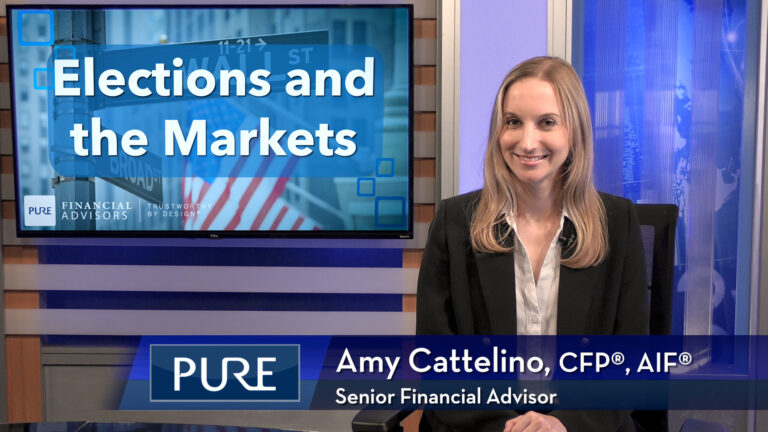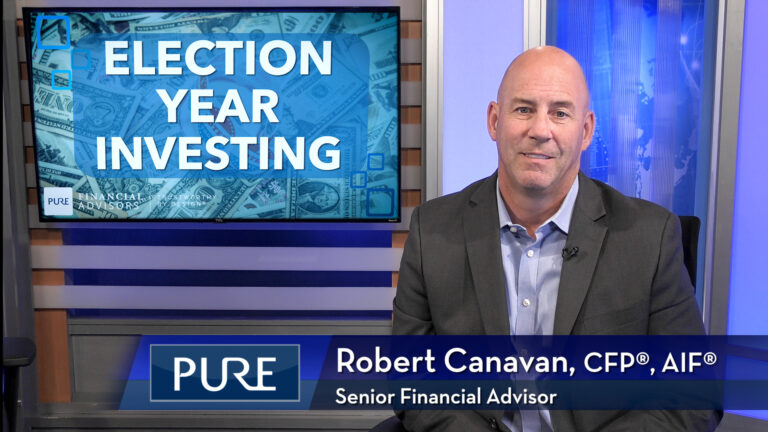If a large share of your investment portfolio is in a single stock, it may represent an unnecessary risk to your overall wealth. You may need to sell some of that company stock, but how do you diversify a concentrated stock position in the most tax-efficient way possible to minimize capital gains tax? Is tax-efficiency even the most important consideration?
In this video, Pure Financial Advisors’ Director of Research, Brian Perry, CFP®, CFA® outlines some of the strategies available to diversify that concentrated position depending on your specific circumstances. After doing a tax projection, these strategies might including net unrealized appreciation or NUA, or hedging your risk with options: setting a floor to protect against declines and a cap, ceiling or collar (even a costless collar) to give you some upside. These strategies will allow you to rebalance your portfolio and minimize taxes without exposing yourself to too much risk.
Transcript:
So today we’re gonna talk about what to do with a concentrated stock position – and let’s start with the good news. The good news is you’ve made some money in a stock, and it’s become a larger and larger share of your overall portfolio. The downside is, as a larger share of your portfolio, it may now represent an unnecessary risk to your overall finances and your wealth. And also, you may owe taxes if you try to get out of that position. So what do you do?
Well, what to do depends on what kind of account is it in? If your large holding is in a retirement account, you may not have tax implications. You may be able to just go ahead and sell it and there are no taxes. But that being said, you may have an opportunity: you may be able to do something called net unrealized appreciation, often abbreviated NUA. That’s a tax strategy wherein you’re able to take some of your stock in the retirement plan and roll it out into a non-retirement account, and in doing so, you don’t pay taxes in the moment on the gains in that stock, but only on what you paid for it. It’s a fairly sophisticated strategy and there are some regulations, rules, and requirements around it. So if you want more details on that, either talk to your financial advisor or reach out to us here at Pure Financial for more details.
But now let’s say what if the stock is not in a retirement account? What if it’s in your non-retirement account? Then what do you do? Well, now the problem is, if you sell, you’re going to owe taxes – capital gains taxes. But don’t let taxes wag the investment dog. You’re better off making money paying taxes than having too large of a percentage of your net worth in one position and seeing it fall. Plenty of great companies have suffered that fate. We need look no further than, recently, Sears going bankrupt. Sears at one point in the early 1980s was the biggest retailer in America. There’s a host of other examples, from Enron and WorldCom on through Lehman Brothers and beyond. So you don’t want too much of your wealth in one position. So what can you do though to reduce your holding but without paying too much in tax?
Well, one thing you can do is start by doing a tax projection. What tax bracket are you in today? How much of the stock could you get out of without unduly harming yourself from a tax perspective? Whatever amount that is, sell some. Sell some of the stock today. Start reducing that position. What about the rest? Well, you still have a large holding, and as you approach your enter into retirement, that could be too much of a risk to take on. So what you can do is you can hedge it.
And here you can do that in a variety of ways, one of them would involve options. And options you might hear about in the news. Sometimes they can be very risky. You can use options to take great risk in a portfolio, but originally, they were designed to protect farmers against adverse changes in the price of their crops and protect them – hedge them – into the future. And you can do that with stocks too. You can put essentially a floor under a stock.
So let’s say, hypothetically, a stock is trading at $100 and you can’t sell it all due to taxes, or you don’t want to sell at all due to taxes. What you can do with options is you can put a floor under the stock of let’s say $80. That means that if the stock gets cut in half, you don’t suffer the whole decline. You can still sell it at that $80. There’s a cost to that of course, it’s like buying insurance – nothing it’s free. But sometimes what you can do on the other side of that is another strategy where you do what’s known as a collar.
And essentially what you do is you put a ceiling on your stock as well – you give up some of the upside. So again in that example where the stock’s trading at $100, you put a floor under it at $80 – maybe you’re willing to put a ceiling on it at $120. And so now you’ve given up the opportunity to make a lot more money, in exchange for the fact that you won’t lose a lot of money.
And that’s OK because you’ve already made large gains on this stock which is why it’s a concentrated position. A lot of times, in a lot of circumstances, you can enter into this kind of scenario without actually a whole lot of money out of pocket. Sometimes it can even be what’s known as a costless collar which means it’s free, essentially, to put into place. So that’s a way to protect yourself against future movements.
And then what you do is, each year, you look at what position you’re in from taxes and how much of the stock you can get out. So you wind up reducing your stock position across the course of several years in a tax-efficient manner, while all the time having yourself protected with the use of those options. It’s a fantastic way to really rebalance your overall finances, your overall wealth, while not killing yourself with taxes or subjecting yourself to unnecessary market risk with that one stock.
And as you reduce that holding, what you do is you then put it into a globally diversified balanced portfolio. And when you’re building that portfolio, take into account that concentrated position. And what I mean by that is, let’s say that but one position is half your wealth and you can’t get out of it right now, you’re getting out of it over the course of years. Maybe you hold in your diversified portfolio, all else being equal, slightly fewer stocks. Slightly more, let’s say, bonds, because you have this large concentration of stock over there. So you definitely want to take into account the large concentrated position in the context of your globally diversified overall portfolio.
Again, concentrated positions can be a challenge because now you have this risk that you didn’t have in the past. But it’s also an opportunity because you’ve made money, now you want to preserve the money. You want to preserve your wealth in order to set yourself up for a fantastic life down the road. And you do that by, in a tax-efficient way, moving out of the position while putting a floor, potentially, underneath that position in the meantime. For more information on concentrated positions, managing your overall wealth, or anything else, visit us at PureFinancial.com.
Click here for more information on diversification of investments.













